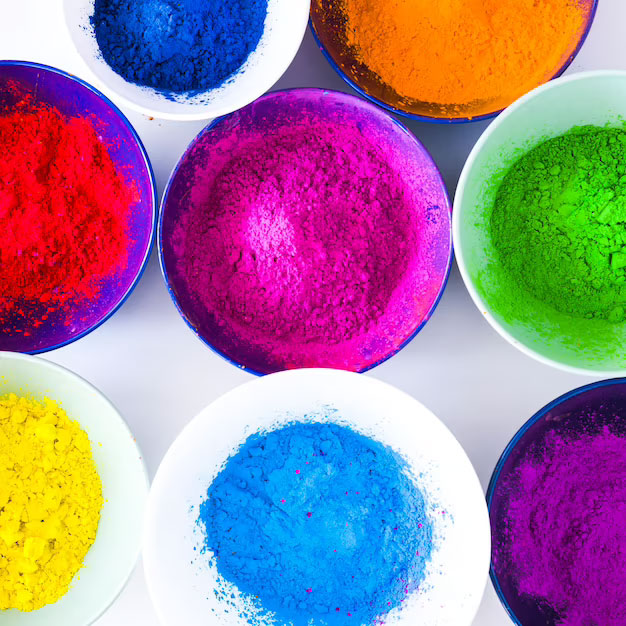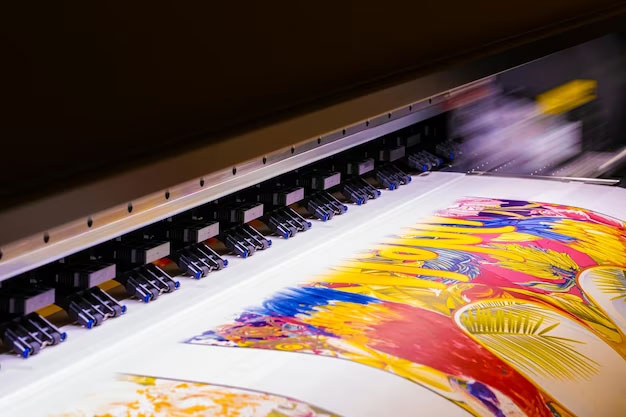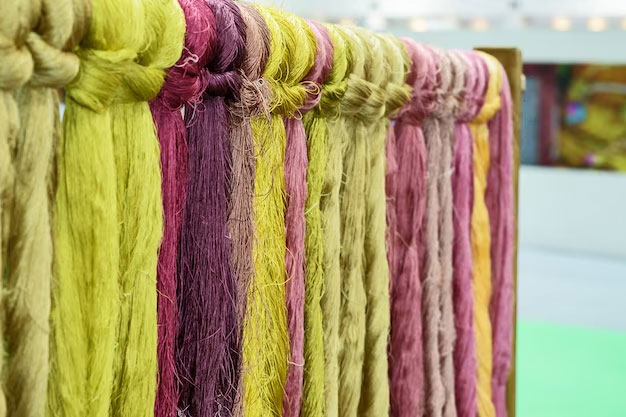Manufacturer, Supplier & Exporter of
a wide range of Dyes, Pigments & Food Colours
HE Dyes
Introduction to HE Dyes
HE Dyes, or high exhaust dyes, are based on “Bis-Monochloro Triazine” Reactive system. This type of dye is ideal for dyeing cotton and other cellulosic materials. These dyes possess significantly higher exhaustion and fixation efficiency which results in appreciable cost reduction compared to conventional reactive dyes. The high fixation and good build-up are particularly important when dyeing polyester/cellulosic blends, where the liquor to goods ratio is quite high.
One of the advantages of Reactive HE Dyes is that the drained and washed liquors after dyeing contain much less quantity of unfixed dyes, making them of interest when pollution control is a major concern. This also facilitates quicker wash-off and efficient soaping. The improved stability of HE Dyes provides improved batch-to-batch consistency.
Exhaustion of HE reactive dyes can be controlled by salt addition and temperature to give level dyeing before alkali addition. Overall, HE Dyes are suitable for dyeing cotton and other cellulosic materials due to their superior exhaustion and fixation properties.
Megha International is a leading HE dyes manufacturer that specializes in the production and distribution of various other dyes and chemicals. As prominent dye manufacturers in India, we offer a wide range of high-quality dyes, including HE Dyes, which are used in textile and other industries. Megha International is committed to providing innovative and sustainable solutions to their customers’ needs, and their products are known for their consistency, reliability, and performance.
Are you looking for HE Dyes? Transform your materials into vibrant masterpieces!
Buy High quality HE Dyes at Best Price - Megha International

Types of Reactive Dyes (Highly Exhaust Dyes Shade Card): - Megha International
| HE Dyes | Solubility G/L | Suitability | Fastness Properties | ||||||||||||||||||
| 2% | Product Name | C. I. Name | CAS NO. | Affinity | Metal Complex Dyes | Plain Water | With 50 G/L Salt | With 100 G/L Urea | Exhaust | Dischargeability | Light 1/1 | Washing C/ST ISO4 | Perspiration | Naocl C/ST | H₂O₂ | Chlorinated Water | HE dyes uses | Price | MSDS | TFDS | |
| Acidic C/ST | Alkali C/ST | ||||||||||||||||||||
| Yellow HE6G | Yellow 135 | 77907-38-1 | H | No | 70 | 25 | 120 | 80-85 | ND | (4-5) | 4-5 5 |
4-5 5 |
4W 4 |
(1-2) | 3 | 3 | fluorescent tracer, for staining proteins, DNA, and RNA in gel electrophoresis | ||||
| Yellow HE46 | Yellow 81 | 2783-94-0 | H | No | 75 | 20 | 35 | 80-85 | D | (4-5) | 4-5 5 |
4-5 5 |
4 4 |
(1-2) | 3 | 2DL | dyeing wool, silk, nylon, and leather | ||||
| Yellow HE4R | Yellow 84 | 61951-85-7 | H | No | 70 | 20 | 100 | 80-85 | D | 5 | 5 5 |
4-5 4-5 |
4-5 4-5 |
(2-3) | 4-5 5 |
4 | dyeing wool, silk, and nylon | ||||
| Orange HER | Orange 84 | 91261-29-9 | H | No | 90 | 50 | 100 | 80-85 | ND | (3-4) | 4-5 4-5 |
3-4 4-5 |
4W 4 |
(2-3) | 4 4-5 |
3 | dyeing wool, silk, and nylon | ||||
| Orange HE2R | Orange 86 | 57359-00-9 | H | No | 60 | 40 | 80 | 80-85 | ND | (3-4) | 4 5 |
4 | 3 | (2-3) | (4-5) | 3 | dyeing wool, silk, and nylon | ||||
| Red HE3B | Red 120 | 61951-82-4 | H | No | 125 | 100 | 130 | 80-85 | ND | 5 | 5 4-5 |
4-5 4-5 |
4-5 5 |
(1-2) | 4 4-5 |
4 | dyeing wool, silk, and nylon, and in biological staining | ||||
| Red HE7B | Red 141 | 61931–52–0 | H | No | 150 | 100 | 150 | 80-85 | ND | (4-5) | 4-5 5 |
5 4-5 |
5 4-5 |
(3-4) | (4-5) | 4 | dyeing wool, silk, and nylon | ||||
| Red HE8B | Red 152 | 71870-80-5 | H | No | 150 | 150 | 140 | 80-85 | ND | (4-5) | 4-5 2-3 |
4 | (4-5) | 3-A BL |
(4-5) | 4-5 BL |
dyeing wool, silk, and nylon | ||||
| Green HE480 | Green 19 | 61931-49-5 | H | No | 80 | 40 | 125 | 80-85 | ND | 4 4 |
4-5 4-5 |
4-5 5 |
4-5 4 |
1 | 3-4 4-5 |
(2-3) | dyeing wool, silk, and nylon, and in biological staining | ||||
| Turquoise Blue HA | Blue 71A | 7220-79-3 | H | Yes | 110 | <10 | 140 | 80-85 | ND | 5 3-4 |
3-4 3-4 |
4-5 5 |
4-5 5 |
(3-4) | 2 | 3 | dyeing wool, silk, and nylon, and in biological staining | ||||
| Blue HERD | Blue 160 | 71872-76-9 | H | Yes | 90 | 65 | 100 | 80-85 | MD | (5-6) | 4-5 4-5 |
4-5 5 |
4-5 4-5 |
1 | 3 4 |
3 | dyeing wool, silk, and nylon, and in biological staining | ||||
| Navy Blue HER | Blue 171 | 77907-32-5 | H | No | 90 | 20 | 125 | 80-85 | MD | 4 | 4-5 4-5 |
4-5 4-5 |
4 4-6 |
2-3 DL |
4 4-5 |
(3-4) | dyeing wool, silk, and nylon, and in biological staining | ||||
| Black HEBL | Black 5 | NA | H | No | (4-5) | (4-5) | (4-5) | 70-80 | Yes | (6-7) | (4-5) | (4-5) | (4-5) | (4-5) | (4-5) | (4-5) | Used in textile dyeing and printing | ||||
| Reactive Red BS | Red 69 | NA | H | No | (4-5) | (4-5) | (4-5) | 70-80 | Yes | (4-5) | (4-5) | (4-5) | (4-5) | (4-5) | (4-5) | (4-5) | Used for dyeing cotton and cellulose fibers | ||||
| Reactive Red DS4B | Red 180 | NA | H | No | (4-5) | (4-5) | (4-5) | 70-80 | Yes | (4-5) | (4-5) | (4-5) | (4-5) | (4-5) | (4-5) | (4-5) | Used for dyeing cotton and cellulose fibers | ||||
| Reactive Red W3R | Red 180 | NA | H | No | (4-5) | (4-5) | (4-5) | 70-80 | Yes | (4-5) | (4-5) | (4-5) | (4-5) | (4-5) | (4-5) | (4-5) | Used in textile dyeing and printing | ||||
| Reactive Deep Red CD | Red 194 | NA | H | No | (4-5) | (4-5) | (4-5) | 70-80 | Yes | (5-6) | (4-5) | (4-5) | (4-5) | (4-5) | (4-5) | (4-5) | Used in textile dyeing and printing | ||||
| Reactive Deep Red SB | Red 239 | NA | H | No | (4-5) | (4-5) | (4-5) | 70-80 | Yes | (5-6) | (4-5) | (4-5) | (4-5) | (4-5) | (4-5) | (4-5) | Used for dyeing cotton and cellulose fibers | ||||
| Reactive Yellow RGB | Yellow 145 | NA | H | No | (4-5) | (4-5) | (4-5) | 70-80 | Yes | (3-4) | (4-5) | (4-5) | (4-5) | (4-5) | (4-5) | (4-5) | Used in textile dyeing and printing | ||||
| Reactive Red RGB | Red 195 | NA | H | No | 4 | 4 | 4 | 70 | Yes | 6 | 4 | 4 | 4 | 4 | 4 | 4 | Used for dyeing cotton and cellulose fibers | ||||
| Reactive Blue RGB | Blue 19 | NA | H | No | 4 | 4 | 4 | 70 | Yes | 6 | 4 | 4 | 4 | 4 | 4 | 4 | Used for dyeing cotton and cellulose fibers | ||||
| Reactive Navy RGB | Blue 172 | NA | H | No | 4 | 4 | 4 | 70 | Yes | 6 | 4 | 4 | 4 | 4 | 4 | 4 | Used in textile dyeing and printing | ||||
| Reactive Orange W3R | Orange 84 | NA | H | No | 4 | 4 | 4 | 70 | Yes | 6 | 4 | 4 | 4 | 4 | 4 | 4 | Used in textile dyeing and printing | ||||
| Reactive Orange CD/GDR | Orange 122 | NA | H | No | 4 | 4 | 4 | 70 | Yes | 6 | 4 | 4 | 4 | 4 | 4 | 4 | Used in textile dyeing and printing | ||||
| Reactive Brown GR | Brown 18 | NA | H | No | 4 | 4 | 4 | 70 | Yes | 6 | 4 | 4 | 4 | 4 | 4 | 4 | Used for dyeing cotton and cellulose fibers | ||||
| Reactive Red Violet ME | Red 195 | NA | H | No | 4 | 4 | 4 | 70 | Yes | 6 | 4 | 4 | 4 | 4 | 4 | 4 | Used in textile dyeing and printing | ||||
| Reactive Red 111 | Red 111 | NA | H | No | 4 | 4 | 4 | 70 | Yes | 6 | 4 | 4 | 4 | 4 | 4 | 4 | Used for dyeing cotton and cellulose fibers | ||||
Properties of HE Dyes
- Higher exhaustion efficiency: HE Dyes have a significantly higher exhaustion efficiency compared to conventional reactive dyes. This means that a smaller amount of dye is required to achieve the desired level of coloration, resulting in cost savings.
- Good fixation: HE Dyes have excellent fixation properties, which means that they bind well to the fibers and are less likely to wash out or bleed during subsequent washings.
- Improved stability: HE Dyes have improved stability, which ensures consistency and batch-to-batch reproducibility of the dyeing process.
- Low unfixed dye content: The drained and wash liquors after dyeing contain much less quantity of unfixed HE dyes compared to conventional reactive dyes. This is important for pollution control and efficient washing and soaping.
- Controlled exhaustion: The exhaustion of HE Dyes can be easily controlled by adjusting the salt addition and temperature before alkali addition, resulting in level dyeing.
Advantages of HE Dyes
HE Dyes, or Highly Exhausted Dyes, have several advantages that make them a popular choice for dyeing cotton and other cellulosic materials. These advantages include:
- Cost savings: HE Dyes have a significantly higher exhaustion efficiency, which means that a smaller amount of dye is required to achieve the desired level of coloration, resulting in cost savings.
- Better fixation: HE Dyes have excellent fixation properties, which means that they bind well to the fibers and are less likely to wash out or bleed during subsequent washings. This results in a more vibrant and long-lasting colour.
- Improved environmental sustainability: The reduced quantity of unfixed dye in the drained and washed liquors after dyeing means that HE Dyes are more environmentally sustainable than conventional reactive dyes. They also require less water and energy during the dyeing process.
- Controlled exhaustion: The exhaustion of HE Dyes can be easily controlled by adjusting the salt addition and temperature before alkali addition, resulting in level dyeing and better reproducibility.
- Versatility: HE Dyes are suitable for dyeing a wide range of cotton and cellulosic materials, including blends with polyester, making them a versatile choice for various textile applications.
Overall, the advantages of HE Dyes include cost savings, improved fixation, environmental sustainability, controlled exhaustion, and versatility. These benefits have made HE Dyes a popular choice for dyeing cotton and other cellulosic materials.
Uses of Reactive Dyes (Highly Exhaust)
HE Dyes, or Highly Exhausted Dyes, find applications in various industries where cotton and other cellulosic materials are used. Some of the industries that use HE Dyes include:

Textile Industry
HE Dyes are commonly used in the textile industry for dyeing cotton and other cellulosic fibers. They are particularly useful for dyeing denim fabrics, as well as cotton/polyester blends.

Garment Industry
HE Dyes are also used in the garment industry for dyeing cotton and other cellulosic fabrics. They are preferred for their excellent fixation properties, which ensure long-lasting colour and reduced colour bleeding.

Home Textiles industry
HE Dyes are widely used in the home textiles industry for dyeing bed linens, towels, and other cotton-based products. They are preferred for their cost-effectiveness and improved environmental sustainability.
Overall, HE Dyes find applications in various industries where cotton and other cellulosic materials are used, including the textile, garment, home textiles, and automotive industries.
About Megha International
Looking for a HE Dyes Exporter for brazil?
Megha International (ISO 9001: 2008) Established in the year 1995, at Mumbai, India is the best dyes manufacturers in Mumbai that offers different types of dyes in national as well as international markets. Our research and development team carries out constant studies to develop products that reliably set us apart from our competitors and serve our clientele best. With a remarkable focus on innovation and leveraging new-age expertise, we endeavour to sustain and develop a leading organization on a global scale. The company is a top HE Dyes manufacturer in India, and is striving to deliver the finest quality of products to the consumers, while being environmentally sensitive.
Market Area of Megha International
As a prominent HE Dyes supplier, Megha International is proud to export Reactive dyes in a wide range of countries across the globe. Our reach extends to many countries in Asia, including China, Vietnam, Singapore, Thailand, Malaysia, Korea, Philippines, Japan, and Indonesia.
We also serve clients in the Middle East, such as UAE, Saudi Arabia, Kuwait, Qatar, Iraq, and Iran.
In North Africa, we have clients in Algeria, Morocco, and Tunisia, while in Europe, we offer our services to Russia, the UK, France, Italy, Germany, the Netherlands, Romania, and Poland.
In South America, we serve clients in Brazil, Argentina, Colombia, Peru, and Guatemala, as well as in Central America, including Mexico, Costa Rica, and Honduras.
Finally, we also provide our services to clients in the United States and Chile. No matter where our clients are located, we are committed to delivering high-quality dyes and exceptional customer service.
Frequently Asked Question about Hot Brand Reactive Dyes
HE Dyes, or Highly Exhausted Dyes, are a type of reactive dye that possess significantly higher exhaustion and fixation efficiency than conventional reactive dyes.
HE Dyes offer cost savings, improved fixation, environmental sustainability, controlled exhaustion, and versatility.
HE Dyes are suitable for dyeing cotton and other cellulosic materials, including blends with polyester.
HE Dyes are more environmentally sustainable than conventional reactive dyes as they result in reduced quantity of unfixed dye in the drained and wash liquors after dyeing.
HE Dyes have significantly higher exhaustion and fixation efficiency, resulting in cost savings and improved color fastness.
Yes, HE Dyes are commonly used for dyeing denim fabrics.
The exhaustion of HE Dyes can be easily controlled by adjusting the salt addition and temperature before alkali addition, resulting in level dyeing and better reproducibility.
HE Dyes find applications in various industries where cotton and other cellulosic materials are used, including the textile, garment, home textiles, and automotive industries.
The shelf life of HE Dyes varies depending on the manufacturer and storage conditions. However, they generally have a longer shelf life than conventional reactive dyes.
HE Dyes should be handled with care and according to the manufacturer’s instructions. They may cause skin and eye irritation, and prolonged exposure may cause respiratory problems. It is recommended to use personal protective equipment while handling HE Dyes.
